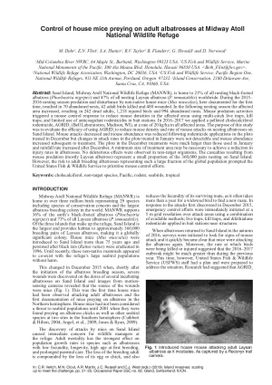Control of house mice preying on adult albatrosses at Midway Atoll National Wildlife Refuge
- Description:
- Sand Island, Midway Atoll National Wildlife Refuge (MANWR), is home to 21% of all nesting black-footed albatross (Phoebastria nigripes) and 47% of all nesting Laysan albatross (P. immutabilis) worldwide. During the 20152016 nesting season predation and disturbance by non-native house mice (Mus musculus), here documented for the first time, resulted in 70 abandoned nests, 42 adult birds killed and 480 wounded. In the following nesting season the affected area increased, resulting in 242 dead adults, 1,218 injured birds and 994 abandoned nests. Mouse predation activities triggered a mouse control response to reduce mouse densities in the affected areas using multi-catch live traps, kill traps, and limited use of anticoagulant rodenticides in bait stations. In 20162017 we applied a pelleted cholecalciferol rodenticide, AGRID (Bell Laboratories, Madison, WI), at a rate of 20 kg/ha in all affected areas. The purpose of this study was to evaluate the efficacy of using AGRID to reduce mouse density and rate of mouse attacks on nesting albatrosses on Sand Island. Mouse attacks decreased and mouse abundance was reduced following rodenticide applications in the plots treated in December but changes in attack rates in the plots treated in January were not detectable and mouse abundance increased subsequent to treatment. The plots in the December treatments were much larger than those used in January and rainfall rate increased after December. A minimum size of treatment area may be necessary to achieve a reduction in injury rates in albatrosses. No deleterious effects were observed in non-target organisms. The casualties resulting from mouse predation (mostly Laysan albatross) represent a small proportion of the 360,000 pairs nesting on Sand Island. However, the risk to adult breeding albatrosses representing such a large fraction of the global population prompted the United States Fish & Wildlife Service to prioritise mouse control efforts.
- Display date:
- 2019
- Collections:
- Secretariat of the Pacific Regional Environment Programme (SPREP)
- Publisher:
- International Union for Nature Conservation (IUCN)
- Content partner:
- Secretariat of the Pacific Regional Environment Programme (SPREP)
- Availability:
- Not specified
-
Copyright status: All rights reservedFind out more about what you are able to do with this itemThis item is all rights reserved, with means you'll have to get permission from Secretariat of the Pacific Regional Environment Programme (SPREP) before using it. For more information, please see our use and reuse page.What can I do with this item?Non-infringing useNZ copyright law does not prevent every use of a copyright work, and this item may be hosted by an international institute or organisation. You should consider what you can and cannot do with a copyright work.No sharingYou may not copy and/or share this item with others without further permission. This includes posting it on your blog, using it in a presentation, or any other public use.No modifyingYou are not allowed to adapt or remix this item into any other works.No commercial useYou may not use this item commercially.
Welcome and warm Pasifik greetings
The information on this site has been gathered from our content partners.
The names, terms, and labels that we present on the site may contain images or voices of deceased persons and may also reflect the bias, norms, and perspective of the period of time in which they were created. We accept that these may not be appropriate today.
If you have any concerns or questions about an item, please contact us.
